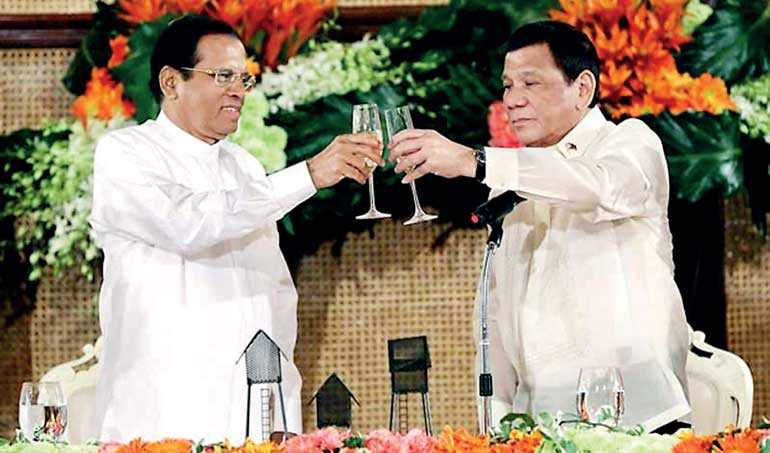Tuesday Jan 20, 2026
Tuesday Jan 20, 2026
Monday, 8 July 2019 00:00 - - {{hitsCtrl.values.hits}}

Sirisena and Duterte appear to have misunderstood each other. The death penalty was abolished in the Philippines in 1987, and Duterte’s method of dealing with the drug problem has been to order the Police to kill suspected drug dealers and drug users
When President Sirisena announced his intention to hang the convicted drug offenders lingering in the death cells of Welikada prison, he was congratulated by President Duterte of the Philippines. When he returned from a recent visit to the Philippines, President Sirisena publicly expressed his admiration of the manner in which President Duterte was dealing with drug offenders in that country.
Sirisena and Duterte appear to have misunderstood each other. The death penalty was abolished in the Philippines in 1987, and Duterte’s method of dealing with the drug problem has been to order the Police to kill suspected drug dealers and drug users. 
Thousands are reported to have been murdered in their homes and on the streets. Duterte once claimed with pride that he himself had killed one or two. Sirisena does not appear to be aware of the pariah status that Duterte has earned for himself within the international community.
President Sirisena has reportedly signed four death warrants requiring the prison authorities to kill one woman and three men by hanging them by their necks until they are dead. It is not known how these four persons were singled out, and by whom.
It was earlier reported that the President had identified 19 prisoners from among those convicted and sentenced to death as those who had been indulging in the drug trade from within the prison premises. That, of course, cannot be the basis for signing a death warrant. None of them have yet been indicted or convicted of the offence of drug trafficking from within prison premises.
A prisoner has first to be charged with that offence, convicted and sentenced to death by a court, had his appeal dismissed, and then been recommended for execution by the Minister of Justice before the President can sign his or her death warrant. Any other course of action will constitute extra-judicial murder.
The legislative history
The death penalty was suspended in 1956 by Act of Parliament on the initiative of Senator M.W.H. de Silva, K.C., Minister of Justice in S.W.R.D. Bandaranaike’s Government. In an emotion-driven decision, it was hurriedly restored through a flawed emergency regulation following the assassination of Bandaranaike in 1959.
In 1976, when I was Permanent Secretary to the Ministry of Justice, a policy decision was reached to suspend judicial executions. Consequently, on 22 May 1977, the fifth anniversary of the Republic, President Gopallawa commuted the sentences of everyone on death row: 144 men and 3 women. Thereafter, President Jayewardene and his successors in office, Presidents Premadasa, Wijetunge, Kumaratunga and Rajapaksa, commuted every sentence of death.
The constitutional obligation
Then, as now, the Constitution prescribed the procedure to be followed when an accused person was sentenced to death by a trial court. Article 34 of our present Constitution states that, following the imposition of such sentence, the President shall cause a report to be made to him by the trial Judge. He shall forward such report to the Attorney General for his advice.
Thereafter, the President shall send both reports to the Minister of Justice who will make the final recommendation whether the sentence should be carried out or whether it should be commuted to life imprisonment. When the President acts on that advice, and makes the appropriate order, the case is closed. The death sentence cannot be reinstated.
The procedure followed when Felix Dias Bandaranaike was Minister of Justice was prescribed in a ministry standing order. If either the trial judge or the Attorney General had recommended that the sentence should not be carried out, the Minister advised that the sentence be commuted to one of life imprisonment.
Then, as now, the Constitution prescribed the procedure to be followed when an accused person was sentenced to death by a trial court
If the trial Judge and the Attorney General had both recommended that the sentence be carried out, a senior assistant secretary examined the case record and the investigation notes for one of three elements: (i) evidence of premeditation (ii) excessive cruelty in the commission of the murder (iii) any other material that ‘shocks the conscience’. If one of these elements was present, the Minister advised the President to let the law take its course.
The Prime Minister has declared that his political party is opposed to the death penalty. Therefore, if the Minister of Justice had, in performing her constitutional duty, followed the policy adopted by her predecessors for 43 years, and advised that every death sentence be commuted to life imprisonment, there would be no prisoners today under sentence of death. They would be serving life sentences. A prisoner serving a life sentence cannot now be hanged.
On the other hand, if there are prisoners still lingering in death row, it means that the reporting procedure in respect of them, as required by the Constitution, has not yet been performed, and they cannot therefore be hanged. It is, of course, possible that the Minister of Justice had, in defiance of her party policy, and in order to accommodate the President’s publicly declared wish to have at least a few human beings hanged before his term of office ends this year, recommended execution.
If that be the case, the Minister’s recommendation will surely be challenged in court as having been influenced by irrelevant considerations. The Minister would not have brought to bear her own independent judgment as required by the Constitution but would instead have been influenced by the President’s publicly declared desire.
Empirical evidence
There is now an international commitment to abolish the death penalty. This is not only because of the desire to respect the dignity of the human being and the sanctity of human life, but also because the global empirical evidence demonstrates beyond any shadow of doubt that the death penalty does not serve as a deterrent. The most effective deterrent to crime is the certainty of detection.
Competent policing, efficient prosecution, and expeditious trial – none of which are evident in Sri Lanka today – should be the primary objective of the Government. If, in the absence of such deterrent, an individual proceeds to a life of crime, the progress that humanity has made through the centuries now demands that that individual be afforded an opportunity for rehabilitation, for reform, for repentance, for hope, for spiritualty, so that one day he or she may be able to enjoy those fundamental rights and freedoms which others outside the prison walls enjoy, but which are only possible if his or her right to life is not extinguished.
The international consensus
The Second Optional Protocol to the International Covenant on Civil and Political Rights requires that no one shall be executed and that each State shall take all necessary measures to abolish the death penalty within its jurisdiction. In 1983, the Council of Europe abolished the death penalty in peacetime, and in 2002 abolished the death penalty in all circumstances, including wartime.
Article 11 of the Constitution states that: “No person shall be subjected to torture or to cruel, inhuman or degrading treatment or punishment”
Similar instruments have been adopted by the states parties to the American Convention on Human Rights. In 2014, the African Commission on Human and Peoples Rights developed a protocol on the abolition of the death penalty. More than 160 of the 193 member-states of the UN have abolished the death penalty or introduced a moratorium, either in law or in practice.
They include all the countries of Europe including Russia, nearly all the countries of Africa, and all the countries of South and Central America and Canada, as well as Australia, New Zealand and much of the Pacific and the Caribbean.
Violation of a fundamental right
Article 11 of the Constitution states that: “No person shall be subjected to torture or to cruel, inhuman or degrading treatment or punishment.” There is now a considerable body of international jurisprudence on the interpretation of this Article. For example, the Constitutional Court of South Africa has held that the death penalty is a ‘cruel punishment’. The Court of Appeal of Tanzania has held the death sentence to be both “cruel and degrading punishment”.
In Canada, three judges of the Supreme Court expressed the view that capital punishment per se constituted “cruel and unusual punishment”: “The death penalty not only deprives the prisoner of all vestiges of human dignity. It is the ultimate desecration of the individual as a human being.”
The Judicial Committee of the Privy Council is among several courts which have held that the mandatory sentence of death, based solely upon the category of crime (e.g. drug related offences in Sri Lanka), without regard to the offender’s personal circumstances or the circumstances of the particular offence, constitutes “cruel, inhuman or degrading treatment or punishment”.
Breaking the 43-year moratorium
If Sri Lanka now breaks its 43-year moratorium on executions, it is inevitable that economic concessions granted by the EU including GSP+ will be withdrawn. Assistance from abroad in the investigation of crime will not be forthcoming. Requests by Sri Lanka for the extradition of persons awaiting trial or already tried and convicted will probably be refused by other States because of the unpredictability of the sentencing policy of the Government.
It was only a few months ago that President Sirisena, in elaborate island-wide ceremonies, proclaimed the Tripitaka as a national heritage, and called upon the international community to inscribe it on the UNESCO Memory of the World Register.
Many beyond our shores who truly and faithfully adhere to the philosophy of life based upon tolerance and compassion as expounded by the Buddha will now stand aghast as the President of the only country in the world whose Constitution requires the State ‘to protect and foster the Buddha Sasana’ addresses four human beings confined in a prison cell and tells each of them: “You are beyond the pale of humanity. You are not fit to live among humankind. You are not entitled to life. You are not entitled to dignity. You are not human. I will therefore annihilate your life.”
A concluding vision
Despite his apparent uncontrollable desire to exercise his power to have a woman and three men killed, it is unlikely that President Sirisena will be present to witness each of them being hanged by his or her neck until he or she is dead.
Therefore, for his benefit, I would entreat him, at sunrise on each of the four mornings, to read to himself the execution of the death penalty as described by Professor Chris Barnard: “The man’s spinal cord will rupture at the point where it enters the skull, electro-chemical discharges will send his limbs flailing in a grotesque dance, eyes and tongue will start from the facial apertures under the assault of the rope and his bowels and bladder may simultaneously void themselves to soil the legs and drip on the floor.”